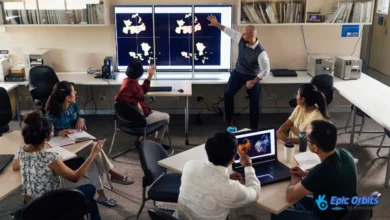Educational Technology Trends and Future Insights
Educational technology means information and communication designed to cover a wide range of information and communication tools.

Often referred to as EdTech, educational technology is transforming teaching and learning by including digital tools, software, and creative approaches that include EdTech improves engagement, accessibility, and individualized learning experiences, from interactive learning systems and artificial intelligence to virtual classrooms and gamification.
Technology is changing, and with it is its effect on education, which is breaking down conventional boundaries and promoting more inclusive and effective learning surroundings. This quick change is determining the direction of education and increasing information availability compared to past times.
Rising over 17% annually, the EdTech industry is expected to reach $598.82 billion by 2032. This points clearly toward digital learning and instruction. Key is online learning, which improves access to, quality of, and efficiency of education.
Knowing the newest technologies and trends is crucial because, in education, innovation keeps developing. This addresses artificial intelligence, machine learning, and data analytics applications. These provide more personalized learning settings and help improve student performance.
Modern Education: The Digital Revolution
The National Education Association claims that digital technologies have tremendously enhanced learning. This shift has improved accessibility to and quality of learning. Now, learning how to use digital technologies is just as crucial as reading and writing.
Teachers should always be learning about fresh technology and instructional strategies. Working with digital businesses, such as HeyTutor, helps produce improved learning strategies. Digital tools, classroom equipment, and online learning are key components of today's education.
- E-learning systems and digital resources provide individualized learning opportunities.
- The use of internet learning possibilities improves access to education significantly.
- Interactive digital resources enhance student involvement and inspire creativity.
Online learning and digital technologies are shining in education. They simplify learning, increase its accessibility, and make it more enjoyable.
Basic Tools for Educational Technology in Contemporary Classrooms
Interactive learning tools and management systems are essential for today's classrooms. Digital learning allows instructors to better monitor student development and create enjoyable sessions. According to studies, 82% of instructors claim digital technologies increase student output and engagement.
Popular are tools like Kahoot!, Quizlet, and Edpuzzle. They include study sets, games, and video tutorials. For instance, Kahoot! boasts more than 100 million games just waiting for you. Quizlet enables users to access study materials from millions of other people all over.
Other important tools include Pear Deck, Flipgrid, and Socrative. They let instructors create interactive presentations and quizzes. Socrative lets instructors create up to five quizzes, totaling fifty students each. Flipgrid allows students to record video answers; therefore, it enhances the interactive nature of education.
Crucially, also, are learning management systems. They let educators monitor student development and handle courses. They also facilitate contact between parents and children. Using these approaches can help instructors make learning more engaging and successful for their pupils.
Educational Technology: Using interactive digital platforms to transform learning
Students' learning is evolving on interactive digital platforms. They simplify and enhance online learning's efficacy and enjoyment. Multimedia and interactive tools abound from Quizlet, Pear Deck, and ClassPoint.
These resources enable educators to design immersive learning opportunities. They suit many learning environments and aptitudes. Such an approach makes learning more interesting to everybody.
Digital technologies and online learning have spawned fresh approaches to instruction. CodeCombat, Kahoot!, and Classcraft all use gamification—with points and badges. It makes studying competitive and entertaining.
Real-time feedback comes from tools such as Formative and Socrates. Teachers may change their instruction based on student performance. This improves pupils' learning.
Tools like Google Classroom, Padlet, and Flipgrid provide support for group projects. They enable pupils to collaborate and experience a community. These resources also provide flexible learning so that students may choose any time, any place.
- 93% of 8- to 12-year-olds possess a smart device, indicating their high level of technological exposure.
- Websites like Quizlet, Pear Deck, and ClassPoint provide multimedia materials and interactive tools that enhance student engagement.
- Platforms such as CodeCombat, Kahoot!, and Classcraft use gamification components—points, badges, and leaderboards—to inspire students.
Online learning and interactive digital tools improve instruction. Teachers have to keep up with growing technologies. They can therefore provide pupils with the greatest education available.
Application of Learning Management Systems: Effective Approach
Success in a classroom depends mostly on a learning management system being perfect. Grade organization and course content organization simplify learning. Studies reveal many students struggle with these methods and need consistency and greater structure.
Systems of learning have several advantages. They enable pupils to access materials anywhere, at any time. They also allow students to organize their grades and homework effectively. Including due dates for every task will help you to maximize these tools. This feature lets pupils monitor their work across many courses.
These guidelines will help you to properly use learning management systems. Make courses efficient and easily available using a checklist. Please ensure that task directions are clearly stated. Please ensure the system is compatible with mobile devices. These actions enhance learning results and assist in building an easily navigable system.
Effective learning management systems enable communication and monitor student development. They also provide online tools. Teachers may customize instruction for every pupil by applying these instruments. This leads to higher grades and increased student interest. Good use of these tools helps to increase the efficiency and effectiveness of education.
Artificial Intelligence used in educational technology
Artificial intelligence is transforming our usage of instructional tools. It facilitates grading and makes learning more personal. A Carnegie Learning survey found that 77% of teachers think AI is useful. Only 56% of them, however, are really utilizing it.
In education, artificial intelligence offers many advantages. It facilitates instructors' jobs, therefore customizing learning to every student. It also increases pupil involvement and learning outcomes. The function of artificial intelligence will become ever more important as technology develops.
AI provides information on what kids need assistance with, thereby enabling instructors. This makes the efficiency and effectiveness of learning more pronounced. Given 97% of education experts believe artificial intelligence will have a beneficial influence, its place in the direction of education seems obvious.
Among the crucial information regarding artificial intelligence in education are
- Of the teachers, 60% claimed to employ artificial intelligence in their courses.
- Of the teachers, 52% turn to artificial intelligence for inspiration and idea production.
- 24% of teachers alter their courses of instruction and assignments using artificial intelligence.
- Twenty percent of teachers operate in districts equipped with tools to identify responses produced by artificial intelligence.
Educational Technology: BYOD Methodologies and Mobile Learning
Schools are seeing increasing popularity for mobile learning and Bring Your Own Device (BYOD) policies. Students may now access instructional resources and collaborate using their devices. This change results from the expansion of online education.
Using digital tools in the classroom increases student participation and customizes instruction for every pupil. Studies reveal that pupils who use mobile devices coordinate better in class. Their gadgets let them collaborate.
Some main benefits of BYOD and mobile learning consist of
- They can easily access instructional resources.
- Students are encouraged to participate in group projects.
- Individual learning experiences are customized for each student.
- This led to an increase in student participation.
Including digital technologies and online learning in their courses can help instructors make learning more engaging and successful. Schools have to follow fresh trends in mobile learning and BYOD as technology develops.
Educational Technology: Data-Driven Instructional Decision Making
Education today depends much on data-driven decision-making. One finds much benefit from educational technologies. Teachers view real-time student performance. They can identify areas of student need for assistance and provide the correct kind of support.
One finds excellent assistance from a learning management system. It allows instructors to compile and examine student performance statistics.
Data enables educators to adapt better, operate more quickly, and impart more effective lessons. Tracking tools and analytics let teachers grasp student learning. A teacher may see, for example, which pupils find a topic difficult. They may then assist such pupils more actively.
These are a few applications of data in the classroom:
- Standardized test results guide pupils toward areas requiring more assistance.
- Monitoring behavior and attendance reveals tendencies.
- Information on student involvement guides educators' decisions.
- Tools for data visualization help one to grasp difficult information easily.
Closing the Digital Divide with Instructional Technology
In the United States, the digital divide creates significant challenges. Online learning materials and digital technologies are not available to many pupils. Reports indicate that one in three Black, Latino, and Native American homes lack computers at home.
For a student, this lack of access might seriously lower their marks. Home fast internet users have an average GPA of 3.18. Those without it score 2.81 on GPA.
Giving pupils digital tools and online learning access can help tackle this. We can do this by partnering with technology firms. Technology firms may provide software and inexpensive or donated gadgets. They may also guide educators in using technology in the classroom.
Additionally beneficial for instructors are online training courses available on websites like Coursera and Khan Academy. They may therefore better use technology in their instruction.
These are several strategies to bridge the digital divide:
- Give pupils internet learning materials and digital technologies.
- Work with technology firms to get software and discounted or given hardware.
- Provide instructors with online instruction so they can incorporate technology into their lessons.
- Work with organizations like the Digital Promise and the Education SuperHighway to enhance internet availability.
We can reduce the digital gap by letting pupils access digital tools and online learning. This means that every kid has an equitable opportunity to achieve. Using digital technologies, internet resources, and community involvement helps us to do this. This covers parent seminars and joint efforts with nearby organizations.
Future-Proofing Learning Environment:
Pressures on educational institutions to be mobile and digital abound. They must use fresh technologies like blockchain and artificial intelligence. Good learning management systems enable instructors to monitor student development and make learning personal.
The 21st-century employment market depends on using educational technology, also known as edtech. Companies desire those with digital abilities. Schools lacking these abilities will lag behind others. Edtech gets pupils equipped for the digital age.
- Using a cloud-based learning management system may lead to improved administrative and decision-making.
- Automate chores to save money and enhance budgeting by cutting waste.
- Design digital skills courses and tests for the IT workforce.
- Give pupils online skills instruction to enable their success.
Following these guidelines helps institutions remain competitive and relevant. One should concentrate on the ethical use of technology. This guarantees that, in education, tech benefits everyone—not just a few.
Conclusion
The use of educational technology, also known as EdTech, has fundamentally altered learning. It makes targeted, simple access to learning more enjoyable. With virtual reality (VR) and online learning systems, among other things, technology will be essential for the direction of education.
Teachers, leaders, and others may enable pupils to be ready for a digital future by embracing this tech shift. Schools using the newest EdTech must also adequately equip their staff. Such preparation enables educators to keep up with fresh teaching strategies and properly use these instruments.
It is also crucial to ensure that everyone in the institution has access to technology. This promotes equitable and inclusive education for everyone. By doing this, we can enable more pupils to enjoy EdTech.
Looking ahead, technology and education will continue to change our approaches to teaching and learning. Changing our perspective will enable us to provide more fascinating, tailored, future-ready education. These changes will help students to flourish in the twenty-first century and forward.



